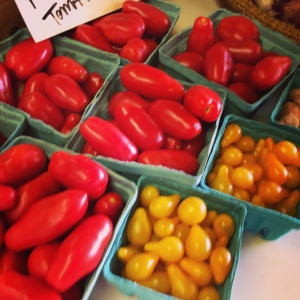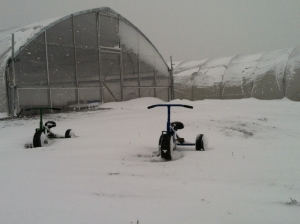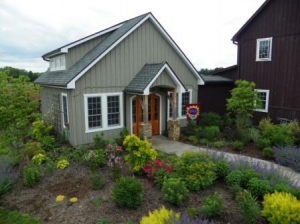
3 Ways to Make Use of an Abundance of Tomatoes
Hello, tomato.

So wonderful to see you again.
Such taste, such loveliness, such flavor… tis’ the season of Jersey-grown tomatoes.
As a tomato lover, I sometimes find myself thinking with my eyes, and come home with more tomatoes than I can possibly consume. What’s a girl to do?
3 Ways to Make Use of an Abundance of Tomatoes
1. Give them away.
I know it may be difficult to give away such perfections of nature, but share the tomato love and give some away. Do you have friends who say they don’t like tomatoes (gasp!)? Gift them with a local tomato in season, at its peak ripeness, and watch them change their tune.
2. Roast them.
If you have less-than-pristine tomatoes, try roasting them in the oven to coax out their flavor. Eat them after roasting, or freeze them to enjoy year-round- roasting concentrates the flavor, so they’ll taste great. David Lebovitz has an excellent recipe here.
3. Can them.
Canning tomatoes sounds intimidating. I am new to canning myself- this summer will be the first time I’m putting up foods for the fall. Canning tomatoes is a big messy endeavor, so make sure you have the help and space you need before you dive in. It’s important to note as well that improperly canned tomatoes can cause botulism, a deadly poisoning. Follow the current USDA guidelines to keep you and your family safe. Mother Earth News has a helpful article on how to can tomatoes at home safely here.
What’s your favorite way to enjoy an abundant tomato harvest?
Winter on the Farm
If you’re like me, you’ve always wondered what goes on at a farm in the winter. You too have imagined farmers burrowing into the barren soil and remaining there, in a state of hibernation, until the warm weather returns. (Or at least sitting around watching Little House on the Prairie reruns.) For most farms, however, wintertime can be surprisingly productive.
At our Pennington, NJ location especially, the colder weather gives us an opportunity to play catch-up on repairs and maintenance. The high tunnels are stripped of their plastic sheathing and their framing realigned, and the tractors and harvesters are overhauled. At Buckingham, where micro-greens are grown year-round in heated greenhouses, hoses, compost, and peat moss must be brought indoors to safeguard against freezing.
Winter is also a time to prepare for the coming growing season. The performance of last year’s harvest is reviewed, with new crops proposed or abandoned based on performance, profitability, and most importantly, customer input. Crop rotation plans are drawn up to ensure soil vitality. Cover crops planted in the autumn also contribute to soil health by capturing and cycling much-needed nutrients, as well as preventing against erosion.
Another wintertime focus is the creation of compost. In late autumn, anywhere from 1000 to 2000 cubic yards of leaf waste are trucked in from neighboring lawns to be composted. This compost is then used as a soil amendment, or sometimes even mixed with the soil itself. A well-balanced compost can help reduce disease, retain water, and discourage the growth of weeds.
Here in the office, the off-season means forging new connections with restaurants, caterers, and retailers. It also means finding novel ways to broaden our relationship with existing supporters. Above all, it is a time to review the previous year’s successes and shortcomings, to fine-tune our processes, to strive to be the very best Blue Moon we can be!
 So while wintertime might see certain bears and hedgehogs retreating underground, it finds us farmers bright-eyed and bushy-tailed, our sleeves rolled up and our thinking caps on, dutifully preparing for the triumphant return of the sun.
So while wintertime might see certain bears and hedgehogs retreating underground, it finds us farmers bright-eyed and bushy-tailed, our sleeves rolled up and our thinking caps on, dutifully preparing for the triumphant return of the sun.
Geothermal Energy Comes to Pennington!
If you’ve been to our Pennington market, you’ve already experienced it—and probably didn’t even know it.
What am I talking about, you ask?
Geothermal energy.
Our market, harvest room, and upstairs living quarters are regulated using a horizontal geothermal heating/cooling system.
Geothermal energy, in its most basic form, is energy that is generated and stored within the Earth. To harness this energy, there are two basic methods. The first uses underground heat to generate electricity. The second, which we use at Blue Moon Acres, utilizes the Earth’s constant underground temperature to provide heating and cooling.
Here’s how it works:
Within the walls runs a circuit of pipes which are filled with an alcohol/water solution. After cycling through the market and harvest area, this circuit travels seven feet below ground, then several thousand feet across the farm, and then back again.
In the summer, hot air is whisked away from the house where it is dispersed through the much cooler underground layer. In the winter, the circuit draws warmth from that same underground layer, which remains at a constant 55 degrees. A series of fans then blows across the cooled/warmed pipes to distribute the temperature evenly.
Some more fun facts:
- If the mercury dips below zero for any length of time, an electric back-up kicks on, keeping the building nice and toasty.
- The temperature is controlled using an ordinary thermostat—same as with a traditional system!
- Excess heat created in the summer is used to satisfy over 90% of the farm’s hot water needs!
All told, the system provides heating/cooling for approximately 5,000 square feet. After the initial start-up investment, the system is inexpensive and reliable. Heating the same size space with electric would cost around $9,000 a year; doing it with oil would cost just under $13,000—and that’s with modern, efficient systems. And let’s not forget the gobs of emissions that are kept out of the atmosphere!
Geothermal may not be the solution to all the world’s problems, but it’s a start. If you’re building a new home or business, or are in the market for a new heating/cooling system, you should give it some thought.




